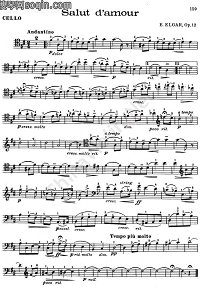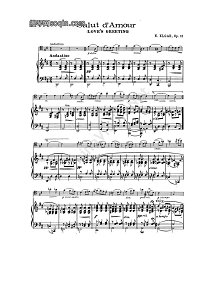Elgar – Salut d'Amour Op.12 for cello and piano
Elgar – Salut d'Amour Op.12 for cello and piano. You can download the PDF sheet music Elgar – Salut d'Amour Op.12 for cello and piano on this page. This excellent expressive composition is the clear sample of music for string instrument by the well-known composer. This composition delight the listener by the well-listened changes of cello and piano melody and different musical features.
To view the first page of Elgar – Salut d'Amour Op.12 for cello and piano click the music sheet image.
|
| PDF format sheet music |
|
|
|
Cello part: 1 pages. 496 K
|
Piano part: 2 pages. 1160 K
|
 |
 |
|
|
| Download PDF (14.99
€) |
Download PDF (14.99
€) |
| Elgar was contemptuous of folk music and had little interest in or respect for the early English composers, calling William Byrd and his contemporaries "museum pieces". Of later English composers, he regarded Purcell as the greatest, and he said that he had learned much of his own technique from studying Hubert Parry's writings. The continental composers who most influenced Elgar were Handel, Dvořák and, to some degree, Brahms. In Elgar's chromaticism, the influence of Wagner is apparent, but Elgar's individual style of orchestration owes much to the clarity of nineteenth-century French composers, Berlioz, Massenet, Saint-Saëns and, particularly, Delibes, whose music Elgar played and conducted at Worcester and greatly admired.
Elgar began composing when still a child, and all his life he drew on his early sketchbooks for themes and inspiration. The habit of assembling his compositions, even large-scale ones, from scraps of themes jotted down randomly remained throughout his life. Diana McVeagh in Grove's Dictionary finds many embryonic Elgarian touches in these pieces, but few of them are regularly played, except Salut d'Amour and (as arranged decades later into The Wand of Youth Suites) some of the childhood sketches. Orchestral works composed during the subsequent years in Worcestershire include the Serenade for Strings and Three Bavarian Dances. In this period and later, Elgar wrote songs and partsongs. W. H. Reed expressed reservations about these pieces, but praised the partsong The Snow, for female voices, and Sea Pictures, a cycle of five songs for contralto and orchestra which remains in the repertory.
Elgar's principal large-scale early works were for chorus and orchestra for the Three Choirs and other festivals. These were The Black Knight, King Olaf, The Light of Life, The Banner of St George and Caractacus. He also wrote a Te Deum and Benedictus for the Hereford Festival. McVeagh makes the point that, because these works of the 1890s were for many years little known (and performances remain rare), the mastery of his first great success, the Enigma Variations, appeared to be a sudden transformation from mediocrity to genius, but in fact his orchestral skills had been building up throughout the decade. |
|